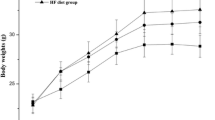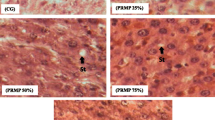Abstract
A low cholesterol (CH)-modified poultry egg (MEΨ) containing more vitamin E, lenolenic acid, and minerals Cu and Mg but low total lipid (TL) and Zn contents than the conventional egg evaluated to reduce the severity of dyslipidemia induced by excessive Zn in the diet. The experimental data was recorded on male rats fed on normolipidemic (NL) semi-synthetic basal diet containing 20 mg Zn/kg diet in control group I, Zn supplemented dyslipidemic diet-A (Zn-DL-A) and B (Zn-DL-B) containing 40 and 80 mg Zn/kg diet in groups II and III, and MEΨ-mixed Test diet-A (Zn-DL-A + 4 MEΨ) and Test diet-B (Zn-DL-B + 4 MEΨ) in groups IIEM and IIIEM, respectively, for 180 and 90 days. Data recorded on liver and blood lipid profiles showed reduction in the concentration of TL, CH, triglycerides, and glycogen (GG) in liver consequently leading to their rise in blood serum including rise in VLDL-c and LDL-c but fall in HDL-c in groups II and III rats that reversed after MEΨ treatment resulting in rise of their levels in the liver and fall in the blood of groups IIEM and IIIEM rats, respectively. Mineral status in the liver showed a rise in Zn but fall in Cu and Mg levels in groups II and III that was reversed after MEΨ treatment resulting in fall in Zn and rise in Cu and Mg concentration in the liver of groups IIEM and IIIEM rats. Hepatopathogical studies showed reduction in the dilatation of long citernal profile of endoplasmic reticulum and increase in GG and TL granules in the cytoplasm of hepatocytes of groups IIEM and IIIEM after MEΨ treatment than those of groups II and III rats. It was concluded that the inclusion of MEΨ would be helpful in reducing dyslipidemia by correcting the ionic imbalance generated by excessive Zn intake in rats or by drugs, even in chronic diseased conditions without aggravating risk factors for heart diseases in humans that need further studies.


Similar content being viewed by others
References
National Cholesterol Education Program (1991) Report of the Expert Panel on Population Strategies for Blood Cholesterol Reduction: executive summary. Arch Intern Med 151:1071–1084
Kritchevsky SB, Kritchevsky D (2000) Egg consumption and coronary heart disease: an epidemiologic overview. J Am Coll Nutr 19:549S–555S
Hu FB, Stampfer MJ, Rimm EB, Manson JE, Ascherio A, Colditz GA, Rosner BA, Spiegelman D, Speizer FE, Sacks FM, Hennekens CH, Willett WC (1999) A prospective study of egg consumption and risk of cardiovascular disease in men and women. JAMA 281:1387–1394
Rimm EB, Stampfer MJ (2000) Antioxidants for vascular diseases. Med Clin North Am 84:239–249
Giovannucci E, Stampfer MJ, Colditz GA, Hunter DJ, Fuchs C, Rosner BA, Speitzer FE, Wilett WC (1998) Multivitamin use, folate, and colon cancer in women in the Nurse’s Health Study. Ann Intern Med 129:517–524
Pelletier X, Thouvenot P, Belbraouet S, Chavvialle JA, Hanesse B, Mayeux D, Debry G (1996) Effect of egg consumption in healthy volunteers: influence and on glycemic and hormonal responses. Ann Nutr Metab 40:109–115
Herron KL, Fernandez ML (2004) Are the current dietary guidelines regarding egg consumption appropriate. J Nutr 134:187–190
Song WO, Kerver JM (2000) Nutritional contribution of eggs to American diets. J Am Coll Nutr 19:556S–562S
Corti MC, Gurlanik JM, Bilato C (1996) Coronary heart risk factors in older persons. Aging (Milano) 2:75–89
Krauss RM, Ecket RH, Howard B, Appel LJ, Daniels SR, Deckelbaum RJ, Edrman JW, Kri-Etherton P, Goldberg IJ, Kotchen TA, Lichtenstein AH, Mitch WE, Mullis R, Robinson K, Wylie-Roset J, St Jeor S, Suttie J, Tribble DL, Bazzarre TL (2000) AHA Dietary Guidelines. Revision 2000: a statement for healthcare professionals from the nutrition committee of the American Heart Association. Stroke 31:27151–27166
Hegsted DM, McGandy RB, Myers ML, Stare FJ (1965) Quantitative effects of dietary fat on serum cholesterol in man. Am J Clin Nutr 17:281–295
Klevay LM (1975) The effect of zinc to copper on cholesterol metabolism. Am J Clin Nutr 28:764–774
Nebia C, Ferrero E, Valenza F, Castagnaro M, Re G, Gennaro SM (1991) Pathologic changes, tissue distribution, and extent of conversion to ethlenthiourea alter sub-acute administration of zinc ethylene-bis-dithiocabamete (zineb) to calves with immature rumen function. Am J Vet Res 52:1717–1722
Bay BH, Tan BK, Sit KH, Hsu A (1996) Cytochorome P450 content and ultrastructural changes in liver of zinc treated C57/6J mice. Pharmacol Res 34:93–97
Folch JLM, Less M, Solane-Stanley GH (1957) A simple method for the isolation and purification of total lipids from animal tissues. J Biol Chem 226:497–509
Chiamori N, Henry RJ (1959) Study of ferric chloride method for the determination of total cholesterol and cholesterol ester. Am J Clin Pathol 31:305–309
Gottfried SP, Rosenberg B (1973) Improved manual spectrophotometric procedure for determination of serum triglycerides. Clin Chem 19:1077–1078
Frings CS, Dunn RT (1970) A colorimetric method for determination of total lipids based on sulpha-phosphovanillin reaction. Am J Clin Pathol 53:89–91
Lowry OH, Rosebroght NJ, Farr AL, Randall RL (1951) Protein measurement with Folin-phenol reagent. J Biol Chem 193:265–275
Heatley NG (1935) The distribution of glycogen in the regions of amphibian gastrula: with a method for the microdetermination of glycogen. Biochem J 29:2568–2572
Taylor SL, Lamden MP, Tappel AL (1976) Sensitive fluorimetric method for tissue tocopherol analysis. Lipids 11:530–538
Barker D, Fitzpatrick MP, Dierenfield ES (1998) Nutrient composition of selected whole invertebrates. Zoo Biol 17:123–134
Bindal MP, Wadhwa BK (1997) Detection of adulteration in ghee with vegetable oils using GLC based on a marker fatty acid. Indian J Dairy Sci 50:129–133
Orgebin-crist MC, Freeman M, Barney GH (1971) Sperm formation in Zn-deficient rats. Ann Biol Anim Biochem Biophys 11:547–558
Seifter S, Dayton S, Movic B, Mtwyler E (1950) The estimation of glycogen with the anthrone reagent. Arch Biochem 25:191
Allen DK, Klevay LM (1978) Cholesterolemia and cardiovascular abnormalities in rats caused by copper deficiency. Atherosclerosis 28:81–93
Umeron J (1989) Serum cholesterol and HDL-cholesterol levels as associated with copper and zinc intake in physically active and sedentary elderly men and women. Adv Exp Med Biol 258:171–181
Gueux E, Rayssiguier Y, Piot MC, Alcindor L (1984) The reduction of plasma lecithin-cholesterol-acyltransferase activity by magnesium deficiency in the rat. J Nutr 114:1479–1483
Harvey PW, Allen KGD (1981) Decreased plasma lecithin-cholesterol acyltransferase activity in copper deficient rats. J Nutr 111:1855–1858
Yount NY, McVamara DJ, Al-othmann AA, Lei KY (1990) The effect of copper deficiency on rat hepatic 3-hydroxy-3-Methylglutaryl-CoA reductase activity. J Nutr Biochem 1:21–27
Al-Othman AA, Rosenstein F, Leik Y (1992) Copper deficiency alters plasma pool size, percent composition and concentration of lipoprotein components in rats. J Nutr 122:1199–1204
Rock E, Astier C, Lab C, Vignon X, Gueux E, Mott C, Rayssiguier Y (1995) Dietary magnesium deficiency in rats enhances free radical production in skeletal muscle. J Nutr 125:1205–1210
Balevska PS, Rosanna EM, Kassabova TA (1981) Studies on lipid peroxidation in rat liver by copper deficiency. Int J Biochem 13:489–493
Paynter DI, Moir RJ, Underwood EJ (1979) Changes in the activity of the Cu-Zn superoxide dismutase enzyme in tissues of the rat with changes in dietary copper. J Nutr 109:1570–1577
Taylor CG, Bettger WJ, Bray TM (1988) Effect of dietary zinc or copper deficiency on the primary free radical generation system in rats. J Nutr 118:613–621
Patterson WP, Winkelmann M, Perry MC (1985) Zinc-induced copper deficiency: mega-mineral sideroblastic anemia. Ann Intern Med 103:385–386
Lin WH, Chen MD, Wang CC, Lin PY (1995) Dietary copper supplementation increases the catecholamine levels in genetically obese (ob/ob) mice. Biol Trace Elem Res 50:243–247
Rasmussen HS, Aurup P, Goldstein K, McNair P, Mortensen PB, Larsen OG, Lawaelz H (1989) Influence of magnesium substitution therapy on blood lipid composition in patients with ischemic heart disease. Arch Intern Med 149:1050–1053
Hamilton IMJ, Gilmore WS, Strain JJ (2000) Marginal copper deficiency and atherosclerosis. Biol Trace Elem Res 78:179–189
Mahley RW, Imnerarity TL (1983) Lipoprotein receptors and cholesterol homeostasis. Biochem Biophys Acta 737:197–222
Paolisso G, Tagliamonte MR, Barbieri M, Zito GA, Gambardella A, Varricchio G, Ragno E, Varricchio M (2000) Chronic vitamin E administration improves bronchial reactivity and increases intracellular magnesium concentration in type-2 diabetic patients. J Clin Endocrinol Metabo 85:109–115
Schmidt EB, Skou HA, Christensen JH, Dyerberg J (2003) n-3 fatty acid from fish and coronary artery disease: implications for public health. Public Health Nutr 3:91–108
Rimm EB, Stampfer MJ, Giovannucci E, Ascherio A, Spiegelman D, Colditz GA, Willett WC (1995) Body size and fat distribution as predictors of coronary heart disease among middle-aged and older US men. Am J Epidemiol 141:1117–1127
Taneja SK, Mahajan M, Arya P (1996) Excess bioavailability of zinc may cause obesity in humans. Experientia 52:31–33
Hu FB, Stampfer MJ, Manson JE, Rimm E, Colditz GA, Rosner BA, Hennekens CH, Willett WC (1997) Dietary fat intake and the risk of coronary Herat disease in women. N Engl J Med 337:1491–1499
Acknowledgments
Thanks are due to Prof. T. Gill for laboratory facilities, Jaya Health Care poultry farm (Panchkula, Haryana, India) to rearing the birds and All India Institute of Medical Sciences (New Delhi, India) for TEM studies. Financial aid provided by the UGC (UGC SAP Phase-III) to the Zoology Department and research fellowship to R. Mandal provided by the Panjab University is gratefully acknowledged.
Author information
Authors and Affiliations
Corresponding author
Rights and permissions
About this article
Cite this article
Taneja, S.K., Mandal, R. Normolipidemic Effect of Antioxidants in Low Cholesterol-Modified Poultry EggΨ on Zn-induced Dyslipidemia and Liver Pathology in Wistar Rats. Biol Trace Elem Res 122, 256–265 (2008). https://doi.org/10.1007/s12011-007-8076-5
Received:
Revised:
Accepted:
Published:
Issue Date:
DOI: https://doi.org/10.1007/s12011-007-8076-5




